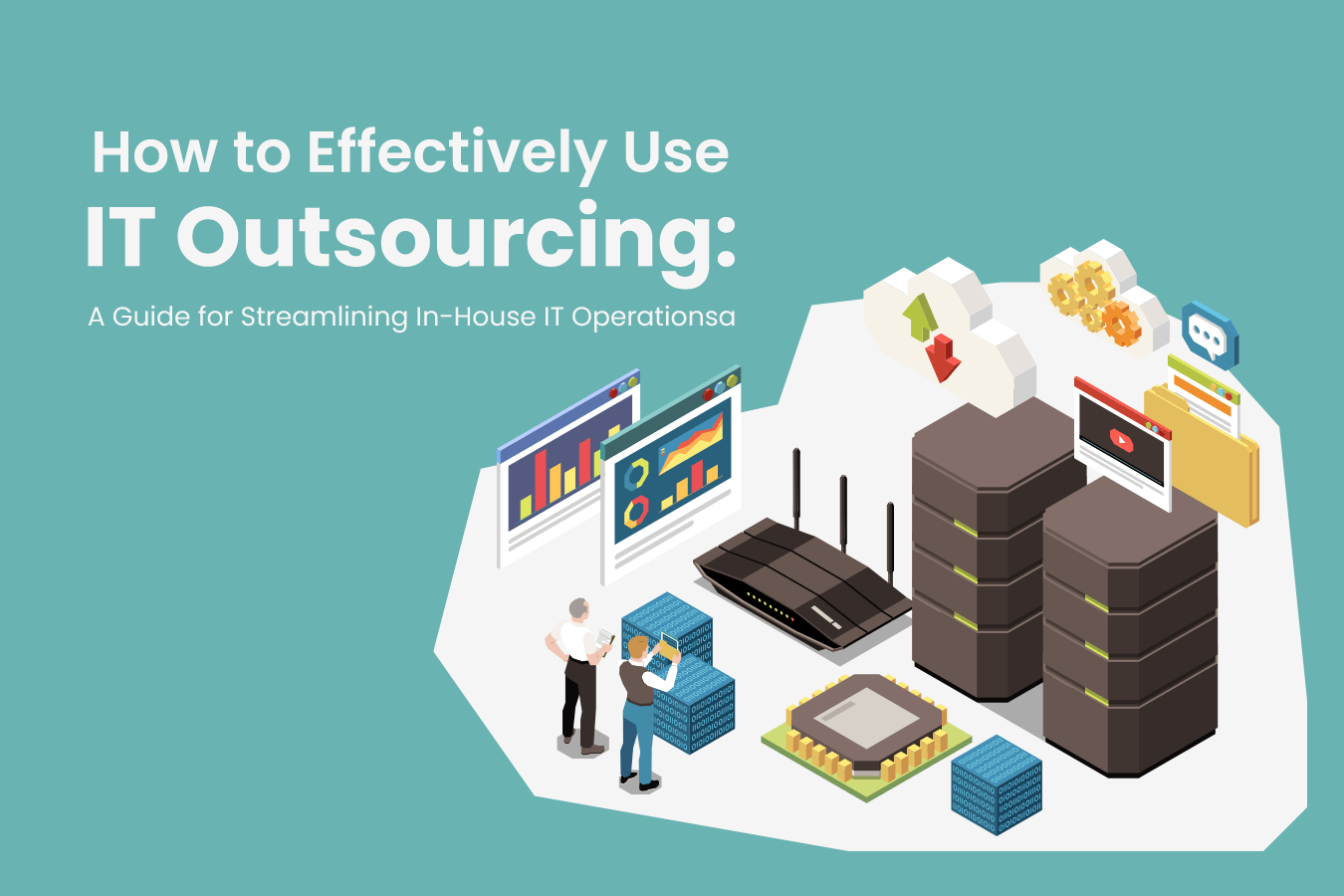How to Effectively Use IT Outsourcing
October 23, 2024

Table of Contents
1. Getting Optimal Results from Outsourcing IT Processes
For IT professionals responsible for managing an organization’s internal systems, work life often feels like a constant stream of challenges. Some of the most common issues that ISF NET clients report include:
- Limited resources and budgets, making it hard to hire and train the necessary talent.
- Increasing IT infrastructure problems and security risks, which are often caused by evolving workstyles and environments. These disruptions can slow down business development and innovation.
- Pressure from top management to adopt AI and cloud tools, even when leadership is unclear about their exact needs, nor understand the time, manpower, and technical expertise required to implement these tools.
As a result of resource constraints and increased burden from low-level routine operations, many strategic business development tasks end up on the back burner. Although there’s an awareness of the need for action, many issues remain unresolved. To enhance efficiency and tackle resource shortages, many organizations consider IT outsourcing.
However, simply delegating tasks to professional service providers doesn’t always produce the desired outcomes. To ensure effective results, a comprehensive understanding of outsourcing is vital. From there, it is necessary to identify and carefully consider the specific challenges your IT team faces before pursuing outsourcing options. By mapping out your operations, you can pinpoint which areas are best suited for optimization through outsourcing.
This article explores common questions about IT outsourcing, including what kind of processes can be outsourced, the different outsourcing models available and what the pros and cons of outsourcing are. In addition, we’ll outline the key steps required to implement outsourcing successfully, starting with how to identify and understand your challenges.
- Models and Processes
Thanks to improvements in technology more and more options are available to companies wishing to outsource their IT processes. There are now several outsourcing models available and an expanding range of IT processes that can be effectively passed to a partner organization. Here’s a quick overview of the most common models and outsourced processes to help you determine which may best meet your needs. - The Onshore Model
This approach involves hiring an external service provider located within the same country to handle IT tasks, either remotely or on-site. This model allows for easy access to local teams who share language, time zone, and cultural similarities. While this is often the preferred option, talent shortages have made it increasingly challenging to find the right Onshore fit. - The Nearshore Model
This model involves delegating IT tasks to a company in a neighboring country. In the US, for example, this would mean looking to Mexico or Canada for an outsourcing partner. Working across borders can have cost benefits and, in most cases, neighboring countries have a good understanding of each other’s cultures and businesses which enables the smooth transfer of operations. - The Offshore Model
Offshore outsourcing means sending IT processes to a company in a distant country, typically one which offers significant cost advantages. It is particularly appealing to companies in tight labor markets where skilled professionals are both difficult to find and expensive to employ.
Having looked at the models, now let’s turn to the most commonly outsourced IT processes:
User Support (Help Desk): Handling inquiries, troubleshooting, creating FAQs, and managing chatbots to provide quick assistance.
- IT Asset Management (Lifecycle Management): Overseeing assets from procurement to returns, repairs, and kitting, ensuring optimal asset utilization.
- Network Management: Managing servers and network equipment, monitoring performance, and implementing robust security measures.
- Account Management: Creating and deleting user accounts, managing access permissions, and ensuring compliance with security policies.
2. The Benefits of Outsourcing IT Operations
Outsourcing IT operations offers several compelling advantages:
- Cost Savings: When companies outsource their operations, a lot of the cost burden they would have from running the processes in house is passed to the service provider. There are two core areas were savings can be made:
- Lower Hiring and Training Expenses: Recruiting and training skilled engineers is both time-consuming and costly. By outsourcing, these cost burdens are passed to the provider.
- Reduced Infrastructure Costs: Running all operations in house requires the purchase, maintenance and management of equipment. With outsourcing, these costs are passed to the service partner.
- Immediate Access to Specialized Skills: Outsourcing partners bring extensive expertise in specific fields, eliminating the need for your company to first look for, hire then train workers – all of which take time and money. By outsourcing, you can get the people you need within a very short space of time.
- Access to Cutting Edge Technology: As well as being able to access top talent quickly, outsourcing can be a rapid gateway to the latest cutting-edge solutions. Rather than investing in, then spending time and money learning how to implement and use the tool, outsourcers will already have it up and running on their systems, understand how best to use it, enabling their clients to adapt it quickly.
- Flexibility and Scalability: Outsourcing facilitates agile responses to fluctuating workloads and organizational growth. You can easily scale resources up or down as needed. This also allows for cost control in response to changing business landscapes.
- Flexible Staffing: This is particularly advantageous when outsourcing a project, since it allows companies to meet their staffing requirements while work is ongoing, then scale back quickly and painlessly once the project has finished.
- Focus on Core Operations: Outsourcing means a company’s IT staff can prioritize strategic IT planning, innovation and critical business projects, while the service provider handles less critical, routine tasks.
3. The Risks of IT Outsourcing and How to Mitigate Them
While outsourcing brings numerous benefits, it also presents some risks that need to be mitigated:
- Control Challenges: If your outsourcing partner lacks a thorough understanding of your internal processes and goals, outcomes may fall short of expectations. Poor communication, a lack of understanding and unclear project requirements can lead to unsatisfactory service deliverables. These in turn result in delays, disruption and missed opportunities.
- Solution: Develop comprehensive operation manuals and schedule regular progress meetings to ensure accurate project management.
- Security Risks: Outsourcing may involve your provider handling sensitive data, which heightens the risk of data leaks or misuse.
- Solution: Implement clearly defined data handling protocols for the outsource partner to follow, include strict obligations for information protection in service contracts and agreements, and conduct regular audits of your outsourcing partners to mitigate risks.
- Dependency Risks: Relying too heavily on a single outsourcing vendor can put a company in a precarious position. This is because, if something happens to impact that vendor’s ability to provide its services, their clients will see major disruptions to their businesses. The greater the reliance the greater the impact.
- Solution: Work with multiple vendors to distribute risk or internalize certain operations to ensure critical functions are not disrupted.
4. Preparation Is Key to Successful Outsourcing
Proper preparation is essential for success. By clearly defining the tasks to be outsourced and setting clear expectations, you can ensure effective implementation. Here are key preparation steps:
- Visualize Operations: Organize and visualize all IT tasks and processes to identify which areas should be and should not be outsourced. Two useful tools are RACI charts and BPMN frameworks:
- RACI Charts: Clearly define different responsibilities in the department – literally who is Responsible, Accountable, Consulted, and Informed for each task.
- BPMN frameworks: These visually model workflows, making it easier to identify bottlenecks and streamline operations.
- Identify Problem Areas: Specify the challenges your team faces and prioritize them. For instance, if multiple projects are ongoing and resources are limited, outsourcing some processes can help free up inhouse staff.
- Select the Right Tasks: The key to successful outsourcing lies in choosing the right tasks to delegate to the vendor. Core operations essential to your company’s competitiveness should remain in-house, while tasks that are not key to your company’s business development such as routine support-related tasks can be outsourced.
- Strategic Focus: By outsourcing non-strategic yet necessary tasks like IT infrastructure management or help desk support, your internal team can concentrate on more strategic initiatives, enhancing overall performance.
- Set Clear Objectives: Establish clear well-defined goals and make sure your outsourcing partner has a thorough understanding of them. With your partner, set measurable targets that will show you how effective their services are.
5. Conclusion
The first step to effectively utilizing outsourcing is understanding what options are available and then visualizing your operations and identifying existing challenges. Building a strong partnership with your outsourcing vendors through effective communication, transparency and shared goals is crucial for success. With careful preparation and strategic implementation, your organization can thrive and enhance productivity.
If you’re considering outsourcing IT operations, ISF NET offers comprehensive services in IT infrastructure management and user support. Our highly-skilled engineers are ready to deliver efficient, high-quality services tailored to your needs.
With over 20 years of experience specializing in IT infrastructure, we have partnered with over 2,000 major companies worldwide. Whether you face workload challenges, want to reduce costs or are having difficulty hiring engineers with the skills you need, contact us for an obligation-free consultation. All our services are available in English with English service support. Contact us here.
Return to the page of Managed Service of the bilingual help desk and onsite | ISF NET, INC.
